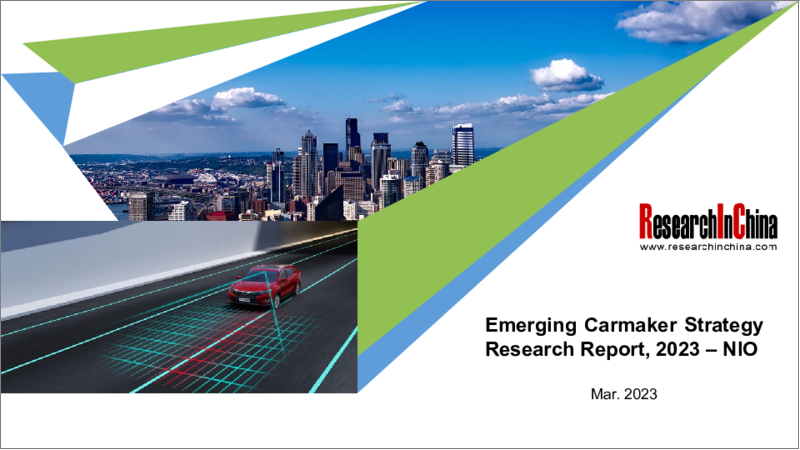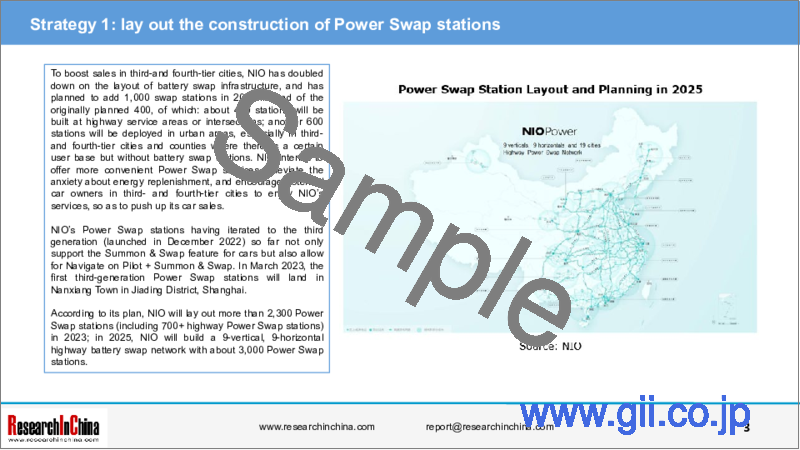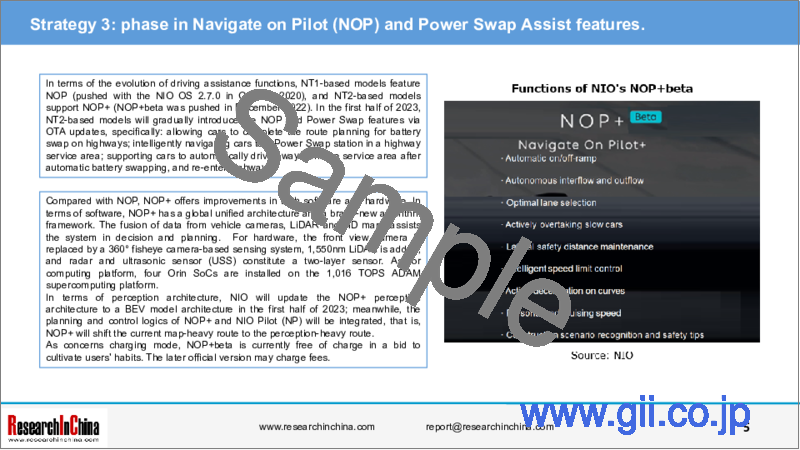|
|
市場調査レポート
商品コード
1250808
新興自動車メーカーの戦略分析(2023年):NIOEmerging Carmaker Strategy Research Report, 2023 - NIO |
||||||
| 新興自動車メーカーの戦略分析(2023年):NIO |
|
出版日: 2023年03月17日
発行: ResearchInChina
ページ情報: 英文 118 Pages
納期: 即日から翌営業日
|
- 全表示
- 概要
- 目次
中国の新興自動車メーカーであるNIOの2022年の販売台数は前年同期比32.3%増の120,134台となっており、モデル別では、ES6、ET7、EC6が販売台数の上位3モデルとなっています。そのうちES6は42,319台が販売され、全体の35.2%を占めています。ES7、ET7、ET5は、納車台数の増加に伴い、販売台数シェアが上昇しました。中でもET7の販売比率が最も高く、19.1%まで伸びています。
当レポートでは、中国の新興自動車メーカーNIOに焦点を当てて、同社の概略や昨今の業績動向、マーケティング・サービス体制、電子および電気アーキテクチャ、電気技術などの情報を提供しています。
目次
第1章 プロファイル
- 基本情報
- 研究開発レイアウト
- 生産モデル
- 販売
- 融資
- 投資
- 納入実績と計画
- 販売量
- 戦略とビジネスモデル
- マーケティングモデル
- マーケティングモデルの実装システム
- マーケティングチャネル
- サービス体制
- サービスネットワーク
- アフターサービス
- 欧州市場でのレイアウト
- 欧州市場での販売モデル
- 欧州におけるオペレーションサービスのレイアウト
- 欧州におけるチャージ・スワップサービスのレイアウト
- 海外における販売量
第2章 電子および電気アーキテクチャ
- 自動車アーキテクチャの進化
- 第1世代EEA:構成
- 第2世代EEA:構成
- 第2世代EEAのハードウェアアーキテクチャ:シャーシドメインコントローラの研究開発モデルと技術
- 第2世代EEAのハードウェアアーキテクチャ:シャーシドメインコントローラの機能
- 第2世代EEAのハードウェアアーキテクチャ:シャーシドメインコントローラの計画
- 第2世代EEAのハードウェアアーキテクチャ:コンピューティングプラットフォーム
- 第2世代EEA:通信アーキテクチャ
- 次世代EEA:構成
- 次世代EEA:ソフトウェアアーキテクチャ
- 次世代EEA:ゾーンコントローラーアーキテクチャ
- NIOと他の新興自動車メーカーのEEA比較
第3章 アプリのユーザー操作
- アプリバージョンイテレーション
- アプリのインターフェース分析
- アプリのコア機能-検出セクション:ホームページ
- アプリのコア機能-検出セクション:推奨事項
- アプリのコア機能-検出セクション:現在地情報
- アプリのコア機能-検出セクション:情報
- アプリのコア機能-検出セクション:モデルの評判
- アプリのコア機能-フレンドセクション
- アプリのコア機能-車セクション
- アプリのコア機能-車セクションの主な機能
- アプリのコア機能-サプライズセクションの製品カテゴリと販売チャネル
- アプリのコア機能-サプライズセクションのNIOライフセールス
- アプリのコア機能-マイセクション
- アプリユーザーサービスシステム運用戦略
- アプリユーザー成長システム-ポイントの獲得方法
- アプリユーザー成長システム-ポイントの消費方法
- アプリユーザー成長システム-ポイントの特徴、機能、および運用モデル
- アプリユーザー成長システム-NIO Valueの割当ルールのイテレーション
- アプリユーザー成長システム-NIO Valueの運用モデルと数値の割当
- アプリユーザー成長システム-NIO Valueの獲得方法
- アプリユーザー成長システム-NIO Valueの適用シナリオ
- アプリの登録とDAU
第4章 電気技術
- モデルイントロダクション
- 「電気駆動・バッテリー・電気制御」技術
- 第2世代の電気駆動システム
- 自動車用バッテリーのレイアウト戦略
- バッテリパックシステムとセキュリティアーキテクチャ
- BMS技術
- BaaSモデル
- バッテリー管理モデル
- バッテリー交換ネットワークのレイアウト
- バッテリー交換ネットワークの計画
- バッテリー交換ステーションのイテレーション
- 第3世代バッテリー交換ステーション
- 充電ネットワークのレイアウト
- 充電システム
- 500kW超高速充電パイルの簡単なイントロダクション
- パワーアップ計画
- パワーオンシナリオとパワーオンクラウドサービスプラットフォームの使用率
- 電化連携力学
- 「電気駆動、バッテリー、電気制御」と主要な電気サプライヤー
第5章 インテリジェントドライビング技術
- 自動運転の機能進化
- 自動運転チップの研究開発レイアウト
- 自動運転ソフトウェアの収益モデル
- 第1世代運転支援システムのNIO Pilot機能
- 第2世代運転支援システムのNIO NAD機能
- NIOと他の新興自動車メーカーとの運転支援システムのハードウェア比較
- NOP+のイントロダクション
- コア機能とNOP+ベータのイテレーション
- NOP+とNOPの比較
- NOPの機能進化
- 自動駐車の開発ロードマップ
- 全自動統合駐車システム
- 自動駐車の機能進化
- 自動運転協調モデルと力学
- ET5/ET7の主な自動運転サプライヤー
第6章 インテリジェントコックピット技術
- IVIシステムのイテレーション
- IVI開発戦略
- OTA開発プロセスと更新モード
- OTA運用プロセス
- OTA分析-頻度別
- OTA分析-年別
- OTA分析-機能別
- OTAアップデートの主な変更点
- OTA障害処理システムとセキュリティメカニズム
- OTA充電モード
- OTAアップデートの戦略と方向性
- インテリジェントコックピットの研究開発戦略と方向性
- パノシネマインテリジェントコックピットの特長
- インテリジェントコックピットARメガネのイントロダクション
- ARメガネ搭載モデル
- 次世代ARグラス
- NOMI音声アシスタントのイテレーション
- NIOと他の新興自動車メーカーとのコックピット相互作用能力の比較
- NIOと他の新興自動車メーカーの自動車エコロジー比較
- IoVのセキュリティ対策
- IoVにおける連携力学
Emerging carmaker strategy research: NIO is deploying battery swap and sub-brands for the knockout match in 2023.
In 2022, the sales surged by 32.3% year on year, being concentrated in first-tier cities.
In 2022, NIO sold 120,134 cars, up by 32.3% on an annual basis, specifically:
ES6, ET7 and EC6 were the top three models by sales, of which 42,319 ES6 cars were sold, accounting for 35.2% of the total sales. As ES7, ET7 and ET5 ("775") were delivered, they saw a rising share of sales. Among them, the sales proportion of ET7 grew fastest, up to 19.1%.
By province, Zhejiang (26,747 units), Jiangsu (18,105 units) and Guangdong (15,626 units) ranked top three by sales.
NIO's cars are largely sold in first-tier cities. In 2022, the first three cities by sales were Shanghai (15,467 units), Hangzhou (10,890 units) and Beijing (6,776 units); users in first-tier cities swept 69.9%, down 5.9 percentage points on the previous year.
Strategy 1: lay out the construction of Power Swap stations
To boost sales in third-and fourth-tier cities, NIO has doubled down on the layout of battery swap infrastructure, and has planned to add 1,000 swap stations in 2023 instead of the originally planned 400, of which: about 400 stations will be built at highway service areas or intersections; another 600 stations will be deployed in urban areas, especially in third- and fourth-tier cities and counties where there is a certain user base but without battery swap stations. NIO intends to offer more convenient Power Swap services, alleviate the anxiety about energy replenishment, and encourage potential car owners in third- and fourth-tier cities to enjoy NIO's services, so as to push up its car sales.
NIO's Power Swap stations having iterated to the third generation (launched in December 2022) so far not only support the Summon & Swap feature for cars but also allow for Navigate on Pilot + Summon & Swap. In March 2023, the first third-generation Power Swap stations will land in Nanxiang Town in Jiading District, Shanghai.
According to its plan, NIO will lay out more than 2,300 Power Swap stations (including 700+ highway Power Swap stations) in 2023; in 2025, NIO will build a 9-vertical, 9-horizontal highway battery swap network with about 3,000 Power Swap stations.
Strategy 2: establish sub-brands to explore the lower end of the market, and enable cockpit and driving integration in the models under the third brand.
In 2022, NIO delivered ET7, ES7 and ET5, three models based on the NT2 platform, and switched from NT1 (the perception system includes cameras, ultrasonic radar, etc.) to NT2 (the perception system adds LiDAR, and upgrades cameras to the high-definition for L4 autonomous driving).
In the first half of 2023, NIO plans to deliver five new NT2-based models and a total of 200,000 cars, and develop the NT3 platform (supporting battery swap and 800V fast charging technology, and carrying batteries made by NIO).
At present, all the cars delivered by NIO are positioned as high-end models priced at higher than RMB300,000. NIO plans to cover the mid-to-high-end and low-to-mid-end markets on the basis of the original high-end brand. In the market of mid-to-high-end cars worth RMB200,000-300,000, NIO will launch "ALPS", a NT3.0-based brand. In the market of low-to-mid-end cars valued at RMB100,000-200,000, NIO will unveil "Firefly", a small-sized car brand to debut in Europe, supporting battery swap and L2+ driving assistance.
NIO's EEA has evolved from the distributed architecture NT1 to the domain centralized (5*DCU) architecture NT2. In the future, the cockpit and driving integration will be available to the models under the third brand "Firefly". In February, 2023, NIO partnered with KEBODA, a provider of automotive intelligent and energy-efficient components, systems and solutions. KEBODA will provide cockpit and driving integrated domain controller solutions for Firefly, covering autonomous driving domain control, cockpit domain control and gateway functions.
Strategy 3: phase in Navigate on Pilot (NOP) and Power Swap Assist features.
In terms of the evolution of driving assistance functions, NT1-based models feature NOP (pushed with the NIO OS 2.7.0 in October 2020), and NT2-based models support NOP+ (NOP+beta was pushed in December 2022). In the first half of 2023, NT2-based models will gradually introduce the NOP and Power Swap features via OTA updates, specifically: allowing cars to complete the route planning for battery swap on highways; intelligently navigating cars to a Power Swap station in a highway service area; supporting cars to automatically drive away from the service area after automatic battery swapping, and re-enter highways.
Compared with NOP, NOP+ offers improvements in both software and hardware. In terms of software, NOP+ has a global unified architecture and a brand-new algorithm framework. The fusion of data from vehicle cameras, LiDAR and HD maps assists the system in decision and planning. For hardware, the front view camera is replaced by a 360° fisheye camera-based sensing system, 1,550nm LiDAR is added, and radar and ultrasonic sensor (USS) constitute a two-layer sensor. As for computing platform, four Orin SoCs are installed on the 1,016 TOPS ADAM supercomputing platform.
In terms of perception architecture, NIO will update the NOP+ perception architecture to a BEV model architecture in the first half of 2023; meanwhile, the planning and control logics of NOP+ and NIO Pilot (NP) will be integrated, that is, NOP+ will shift the current map-heavy route to the perception-heavy route.
As concerns charging mode, NOP+beta is currently free of charge in a bid to cultivate users' habits. The later official version may charge fees.
Strategy 4: highlight immersive cockpit experience and build smartphone and IVI integration.
In terms of cockpit experience, NIO's PanoCinema Intelligent Cockpit comes with the standard configuration of 23 speaker units, which are laid out according to the 7.1.4 channel scheme with 20-channel 1000W power amplifier outputs. Active tuning algorithms and Dolby Atmos bring immersive listening experience.
Based on XR OS, NIO's self-developed exclusive automotive AR operation interface, users can control AR and cockpit functions via NOMI voice assistant, NIO Air Ring and the dedicated smartphone App, when wearing AR glasses. In the future, AR glasses are expected to be combined with HUD or AR HUD. According to the latest patent of AR glasses from NIO in January 2023, its next-generation AR glasses can realize display of vehicle information.
In addition to AR glasses, NIO has also developed the mobile phone business. It aims to offer smartphone and IVI integrated experience, build a people-vehicle-smartphone closed loop, share data and make mobile phones a part of NIO's automotive ecosystem. Its selling point may be software, offering differentiated smartphone and IVI integrated experience. In February 2023, NIO applied for the trademark "NIO PHONE". It will start close beta test in Q2 2023, and begin official release in Q3 2023.
According to its recent 2022 financial report, NIO was still in the red, with the full-year net loss of RMB14.4371 billion, up by 259.4% year on year. To achieve CEO Li Bin's goal of "break even in Q4 2023 and make profit in 2024", NIO, which persists in long-termism, has to face a last-ditch battle in 2023.
Table of Contents
1 Profile
- 1.1 Basic Information
- 1.2 R&D Layout
- 1.3 Production Models
- 1.4 Sales
- 1.5 Financing
- 1.6 Investment
- 1.7 Delivery History and Planning
- 1.7.1 Sales Volume
- 1.8.5 Strategy and Business Models
- 1.8.1 Marketing Models
- 1.8.2 Marketing Model Implementation System
- 1.8.3 Marketing Channels
- 1.8.4 Service System
- 1.8.5 Service Network
- 1.8.6 After-sales Services
- 1.9 Layout in European Market
- 1.9.1 Sales Models in European Market
- 1.9.2 Layout of Operation Services in Europe
- 1.9.3 Layout of Charging/Swap Services in Europe
- 1.9.4 Overseas Sales Volume
2 Electronic and Electrical Architecture
- 2.1 Automotive Architecture Evolution
- 2.2 The First-generation EEA: Composition
- 2.3 The Second-generation EEA: Composition
- 2.3.1 Hardware Architecture of the Second-generation EEA: Chassis Domain Controller R&D Models and Technology
- 2.3.2 Hardware Architecture of the Second-generation EEA: Features of Chassis Domain Controllers
- 2.3.3 Hardware Architecture of the Second-generation EEA: Chassis Domain Controller Planning
- 2.3.4 Hardware Architecture of the Second-generation EEA: Computing Platform
- 2.3.5 The Second-generation EEA: Communication Architecture
- 2.4 Next-generation EEA: Composition
- 2.4.1 Next-generation EEA: Software Architecture
- 2.4.2 Next-generation EEA: Zonal Controller Architecture
- 2.5 EEA Comparison between NIO and Other Emerging Carmakers
3 APP User Operation
- 3.1 APP Version Iteration
- 3.2 APP Interface Analysis
- 3.3 Core Functions of APP - Discovery Section: Home Page
- 3.3 Core Functions of APP - Discover: Recommended
- 3.3 Core Functions of APP - Discover: Now and Here
- 3.3 Core Functions of APP - Discover: Information
- 3.3 Core Functions of APP - Discover: Model Reputation
- 3.4 Core Functions of APP - Friends
- 3.5 Core Functions of APP - Car
- 3.5 Core Functions of APP - Main Functions of Car
- 3.6 Core Functions of APP - Product Categories and Sales Channels of Surprise
- 3.6.1 Core Functions of APP - NIO Life Sales in Surprise
- 3.7 Core Functions of APP - My
- 3.8 APP User Service System Operation Strategy
- 3.9 APP User Growth System - How to Earn Points
- 3.9 APP User Growth System - How to Consume Points
- 3.9 APP User Growth System - Features, Functions and Operating Models of Points
- 3.9 APP User Growth System - NIO Value Assignment Rule Iteration
- 3.9 APP User Growth System - NIO Value Operating Models and Value Assignment
- 3.9 APP User Growth System - How to Earn NIO Value
- 3.9 APP User Growth System - Application Scenarios of NIO Value
- 3.10 Registers and DAU of APP
4 Electric Technology
- 4.1 Model Introduction
- 4.2 "Electric Drive, Battery, Electric Control" Technology
- 4.2.1 The second-generation Electric Drive System
- 4.2.2 Automotive Battery Layout Strategy
- 4.2.3 Battery Pack System and Security Architecture
- 4.2.4 BMS Technology
- 4.2.5 BaaS Model
- 4.2.6 Battery Management Models
- 4.3 Battery Swap Network Layout
- 4.3.1 Battery Swap Network Planning
- 4.3.2 Battery Swap Station Iteration
- 4.3.3 The Third-generation Battery Swap Station
- 4.4 Charging Network Layout
- 4.4.1 Charging System
- 4.4.2 Brief Introduction to 500 kW Ultra-fast Charging Piles
- 4.4.3 Power Up Plan
- 4.5 Usage Ratio of Power-on Scenarios and Power-on Cloud Service Platform
- 4.6 Dynamics in Electrification Cooperation
- 4.7 "Electric Drive, Battery, Electric Control" and Major Electrical Suppliers
5 Intelligent Driving Technology
- 5.1 Functional Evolution of Autonomous Driving
- 5.2 Autonomous Driving Chip R&D Layout
- 5.3 Autonomous Driving Software Profit Models
- 5.4 NIO Pilot Function of the First-generation Driver Assistance System
- 5.5 NIO NAD Function of the Second-generation Driver Assistance System
- 5.6 Driver Assistance System Hardware Comparison between NIO and Other Emerging Carmakers
- 5.7 Introduction to NOP+
- 5.7.1 Core Functions and Iteration of NOP+beta
- 5.7.2 Comparison between NOP+ and NOP
- 5.7.3 Functional Evolution of NOP
- 5.8 Development Roadmap of Automated Parking
- 5.8.1 Fully Automated Integrated Parking System
- 5.8.2 Functional Evolution of Automated Parking
- 5.9 Autonomous Driving Cooperating Models and Dynamics
- 5.10 Main Autonomous Driving Suppliers of ET5/ET7
6 Intelligent Cockpit Technology
- 6.1 IVI System Iteration
- 6.2 IVI Development Strategy
- 6.3 OTA Development Process and Update Modes
- 6.3.1 OTA Operation Process
- 6.3.2 OTA Analysis - by Frequency
- 6.3.3 OTA Analysis - by Year
- 6.3.4 OTA Analysis - by Function
- 6.3.5 Major Changes in OTA Updates
- 6.3.6 OTA Fault Processing System and Security Mechanism
- 6.3.7 OTA Charging Modes
- 6.3.8 OTA Update Strategy and Direction
- 6.4 Intelligent Cockpit R&D Strategy and Direction
- 6.4.1 Features of PanoCinema Intelligent Cockpit
- 6.4.2 Introduction to Intelligent Cockpit AR Glasses
- 6.4.3 Models with AR Glasses
- 6.4.4 Next-generation AR Glasses
- 6.4.5 Iteration of NOMI Voice Assistant
- 6.4.6 Cockpit Interaction Capability Comparison between NIO and Other Emerging Carmakers
- 6.4.7 Automotive Ecology Comparison between NIO and Other Emerging Carmakers
- 6.5 IoV Security Protection Measures
- 6.6 Dynamics of Cooperation in IoV




